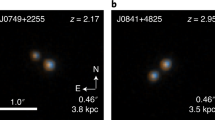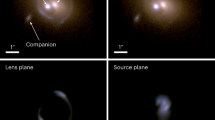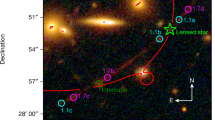Abstract
Three quasar pairs that have been identified as the products of gravitational lenses have no obvious visible lenses1–3. They are: 1146+111 (redshift z=1.01; pair separation Δθ=157 arc s)3, 1635+267 (z=1.96; Δθ=4 arc s)1 and 2345+007 (z=2.15; Δθ=7 arc s)2. An even number (two) of quasar images is observed in each case, although an odd number of images is produced by gravitational lenses with non-singular potentials4. The absence of a visible lens creates, in the lens hypothesis, a severe ‘missing matter’ problem. The missing lenses range in estimated mass3,5 from >1012M⊙ for 1635+267 (where M⊙ is the mass of the Sun) to ∼1015M⊙ for 1146+111. We investigate here the possibility that these quasar images are pairs of physically distinct quasars in galaxy associations. We show that, at the same redshifts as the quasars, only galaxy associations of exceptional richness would be identifiable in the existing data. Less prominent groups of galaxies, such as those known to be associated with nearby quasars6, would not be visible. We calculate the probability of pairs of quasars appearing in galaxy associations and find that physical pairs could appear with the observed frequency if, as expected, quasars are more common relative to galaxy associations at earlier epochs. We also discuss observations that can distinguish between the hypothesis of a gravitational lens and that of physical pairs.
This is a preview of subscription content, access via your institution
Access options
Subscribe to this journal
Receive 51 print issues and online access
$199.00 per year
only $3.90 per issue
Buy this article
- Purchase on Springer Link
- Instant access to full article PDF
Prices may be subject to local taxes which are calculated during checkout
Similar content being viewed by others
References
Djorgovski, S. & Spinrad, H. Astrophys. J. 282, L1–4 (1984).
Weedman, D., Weymann, R. J., Green, R. F. & Heckman, T. M. Astrophys. J. 255, L5–9 (1982).
Turner, E. L. et al. Nature 321, 142–144 (1986).
Burke, W. L. Astrophys. J. 244, L1 (1981).
Turner, E. L. IAU Symp. No. 117, 209–218 (1986).
Stockton, A. Astrophys. J. 223, 747–757 (1978).
Stockton, A. IAU Symp. No. 92, 89–97 (1979).
Stockton, A. Astrophys. J. 257, 33–39 (1982).
Gunn, J. E. et al. Bull. Am. astr. Soc. 16, 477 (1984).
Schneider, D. P., Gunn, J. E. & Hoessel, J. G. Astrophys. J. 264, 337–355 (1986).
Schneider, D. P., Dressler, A. & Gunn, J. E. Astr. J. (in the press).
Bahcall, N. A. Astrophys. J. 232, 689–698 (1979).
Bahcall, N. A. Astrophys. J. 270, 20–38 (1983).
Williams, B. A. & Rood, H. R. Astrophys. J. (in the press) (1986).
Hickson, P. Astrophys. J. 255, 382–391 (1982).
Schmidt, M. & Green, R. F. Astrophys. J. 269, 352–374 (1983).
Author information
Authors and Affiliations
Rights and permissions
About this article
Cite this article
Bahcall, J., Bahcall, N. & Schneider, D. Multiple quasars for multiple images. Nature 323, 515–516 (1986). https://doi.org/10.1038/323515a0
Received:
Accepted:
Issue Date:
DOI: https://doi.org/10.1038/323515a0
This article is cited by
-
Are binary quasars true pairs?
Astrophysics (1989)
Comments
By submitting a comment you agree to abide by our Terms and Community Guidelines. If you find something abusive or that does not comply with our terms or guidelines please flag it as inappropriate.



